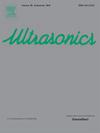Adaptive Doppler blood flow estimation in ultrasound with enhanced spectral resolution and contrast using limited observation windows
IF 3.8
2区 物理与天体物理
Q1 ACOUSTICS
引用次数: 0
Abstract
Measuring blood velocities during the acceleration and deceleration phases of the systolic period can be challenging due to the trade-off between spectral and temporal resolution. This can significantly affect the accuracy of spectrogram reproduction. When temporal samples are reduced, the spectral width may broaden over time, especially during systole. Additionally, shorter observation windows negatively impact factors such as frequency resolution and contrast. This study hypothesizes that a more accurate ultrasound spectrogram can be generated using a new blood velocity estimator with a minimal observation window length of . The spectrogram’s accuracy is assessed using various criteria, including spectral resolution, contrast, and spectral broadening over time. The proposed adaptive method integrates a new coherence-based post-filter with the Eigenspace-based Forward-Backward Amplitude Spectrum Capon (ESB-FBASC) technique. The method’s performance was evaluated in different conditions, including simulations of the femoral artery, stationary and complex flow, and in vivo data. Under rapid flow conditions simulated over three heartbeats in 0.2 s, the proposed method demonstrated better temporal resolution compared to the Welch-Ref estimator, effectively capturing rapid velocity changes and reducing spectral broadening, despite using only slow-time samples. For clinical data on the hepatic vein, the proposed estimator improved spectral resolution by 24 %, 44 %, and 67 %, and increased contrast by 79.8 dB, 120.8 dB, and 155.5 dB compared to MASC, Pr.Capon, and Capon, respectively, for . Furthermore, the narrowest power spectrum width at 40 dB was achieved with the proposed method, showing an improvement of 38 % and 75 % compared to MASC and Pr.Capon, respectively. As a result, the proposed method effectively reduces power spectrum width and enhances spectrogram accuracy by improving spectral resolution and contrast, all while using the limited observation window length of .
自适应多普勒血流估计超声与增强光谱分辨率和对比度使用有限的观察窗口
由于光谱和时间分辨率之间的权衡,测量收缩期加速和减速阶段的血流速度可能具有挑战性。这将显著影响谱图再现的准确性。当时间样本减少时,谱宽可能随着时间的推移而变宽,特别是在收缩期。此外,较短的观测窗口会对频率分辨率和对比度等因素产生负面影响。本研究假设使用最小观察窗长度为N=2的新型血流速度估计器可以生成更精确的超声频谱图。光谱图的准确性是用各种标准来评估的,包括光谱分辨率、对比度和随时间的光谱展宽。提出的自适应方法将一种新的基于相干的后滤波器与基于特征空间的前向后振幅谱Capon (ESB-FBASC)技术相结合。该方法的性能在不同的条件下进行了评估,包括模拟股动脉,静止和复杂的流动,以及体内数据。在0.2秒内模拟三次心跳的快速流动条件下,与Welch-Ref估计器相比,该方法具有更好的时间分辨率,尽管仅使用N=2个慢时间样本,但仍能有效捕获快速速度变化并减小光谱展宽。对于肝静脉的临床数据,在N=2的情况下,与MASC、Pr.Capon和Capon相比,该估计器的光谱分辨率分别提高了24%、44%和67%,对比度分别提高了79.8 dB、120.8 dB和155.5 dB。此外,该方法在40 dB处实现了最窄的功率谱宽度,与MASC和Pr.Capon相比分别提高了38%和75%。结果表明,该方法利用N=2的有限观测窗长,通过提高光谱分辨率和对比度,有效地减小了功率谱宽度,提高了谱图精度。
本文章由计算机程序翻译,如有差异,请以英文原文为准。
求助全文
约1分钟内获得全文
求助全文
来源期刊

Ultrasonics
医学-核医学
CiteScore
7.60
自引率
19.00%
发文量
186
审稿时长
3.9 months
期刊介绍:
Ultrasonics is the only internationally established journal which covers the entire field of ultrasound research and technology and all its many applications. Ultrasonics contains a variety of sections to keep readers fully informed and up-to-date on the whole spectrum of research and development throughout the world. Ultrasonics publishes papers of exceptional quality and of relevance to both academia and industry. Manuscripts in which ultrasonics is a central issue and not simply an incidental tool or minor issue, are welcomed.
As well as top quality original research papers and review articles by world renowned experts, Ultrasonics also regularly features short communications, a calendar of forthcoming events and special issues dedicated to topical subjects.
 求助内容:
求助内容: 应助结果提醒方式:
应助结果提醒方式:


